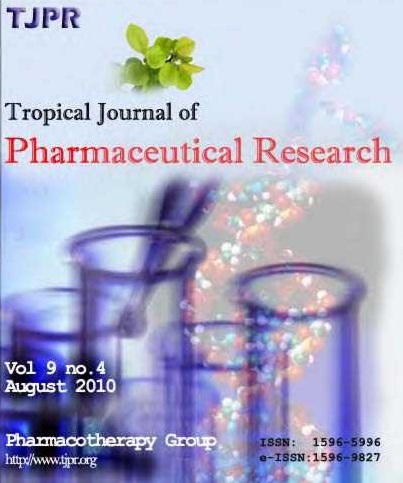Tectorigenin functions as a potential drug for melanoma treatment via inhibition of cell growth, migration and aerobic glycolysis
IF 0.6
4区 医学
Q4 PHARMACOLOGY & PHARMACY
引用次数: 0
Abstract
Purpose: To investigate the role of tectorigenin (TG) in melanoma cells. Methods: Viability of A375 and A2058 melanoma cells was determined by cell counting kit (CCK-8) assay. Cell cycle progression was analyzed by 5-ethynyl-2’-deoxyuridine (EdU) staining. Migration and invasion of melanoma cells were determined by Transwell assay. The epithelial-mesenchymal transition (EMT) of melanoma cells was investigated by determining expression of E-Cadherin and Snail. Expression of glucose transporter 1 (GLUT1) and lactose dehydrogenase A (LDHA) was assessed via western blotting. Glucose and lactate production was evaluated by corresponding assay kit. The NOX4 and FOXM1 expressions were determined using western blotting. Results: Tectorigenin inhibited proliferation, migration and invasion of A375 and A2058 melanoma cells. Tectorigenin regulated cell cycle progression by decreasing the number of cells in S-phase and significantly inhibited snail expression and increased expression of E-Cadherin (p < 0.05), thus inhibiting the EMT of A375 and A2058 cells. Tectorigenin inhibited expression of GLUT1 and LDHA, thereby leading to reduction in glucose consumption and lactate production. It also significantly inhibited expressions of NOX4 and FOXM1 (p < 0.05), indicating an inhibitory effect on the activity of NOX4/FOXM1 pathway. Conclusion: Tectorigenin inhibits aerobic glycolysis, growth and migration in melanoma cells by suppressing the activity of NOX4/FOXM1 pathway, suggesting its potential in melanoma treatment.鸢头黄素通过抑制细胞生长、迁移和有氧糖酵解而成为治疗黑色素瘤的潜在药物
目的:探讨鸢尾黄素(TG)在黑色素瘤细胞中的作用。方法:采用细胞计数试剂盒(CCK-8)法检测A375和A2058黑色素瘤细胞的活力。5-乙基-2 ' -脱氧尿苷(EdU)染色分析细胞周期进程。Transwell法检测黑色素瘤细胞的迁移和侵袭。通过检测E-Cadherin和Snail的表达,研究了黑色素瘤细胞上皮-间质转化(EMT)。western blotting检测葡萄糖转运蛋白1 (GLUT1)和乳糖脱氢酶A (LDHA)的表达。葡萄糖和乳酸的产生用相应的测定试剂盒测定。western blotting检测NOX4和FOXM1的表达。& # x0D;结果:鸢尾黄素对A375和A2058黑色素瘤细胞的增殖、迁移和侵袭均有抑制作用。鸢尾黄素通过减少s期细胞数量调节细胞周期进程,显著抑制蜗牛E-Cadherin的表达,增加E-Cadherin的表达(p <0.05),从而抑制A375和A2058细胞的EMT。鸢尾黄素抑制GLUT1和LDHA的表达,从而导致葡萄糖消耗和乳酸生成的减少。它还能显著抑制NOX4和FOXM1的表达(p <0.05),表明对NOX4/FOXM1通路活性有抑制作用。
结论:鸢尾黄素通过抑制NOX4/FOXM1通路活性,抑制黑色素瘤细胞的有氧糖酵解、生长和迁移,提示其治疗黑色素瘤的潜力。
本文章由计算机程序翻译,如有差异,请以英文原文为准。
求助全文
约1分钟内获得全文
求助全文
来源期刊
CiteScore
1.00
自引率
33.30%
发文量
490
审稿时长
4-8 weeks
期刊介绍:
We seek to encourage pharmaceutical and allied research of tropical and international relevance and to foster multidisciplinary research and collaboration among scientists, the pharmaceutical industry and the healthcare professionals.
We publish articles in pharmaceutical sciences and related disciplines (including biotechnology, cell and molecular biology, drug utilization including adverse drug events, medical and other life sciences, and related engineering fields). Although primarily devoted to original research papers, we welcome reviews on current topics of special interest and relevance.

 求助内容:
求助内容: 应助结果提醒方式:
应助结果提醒方式:


